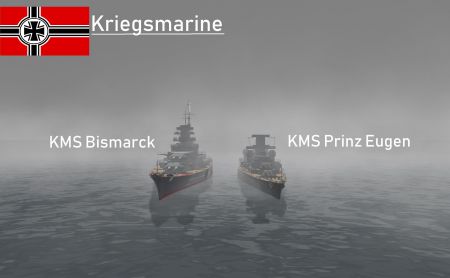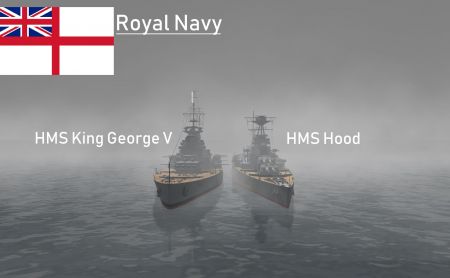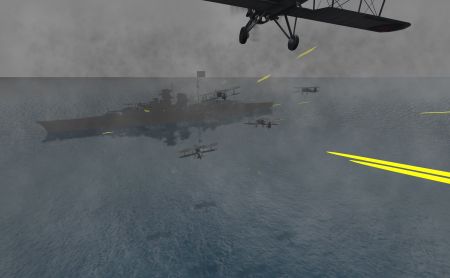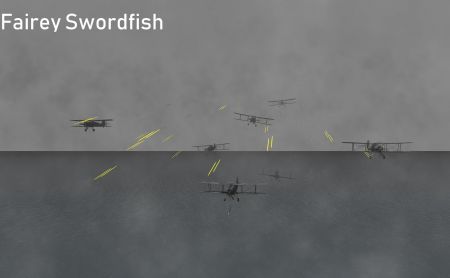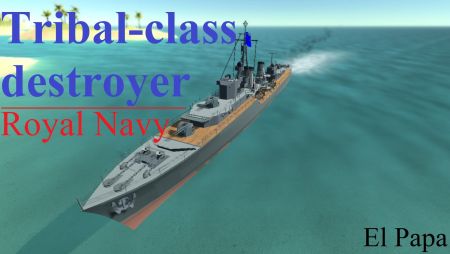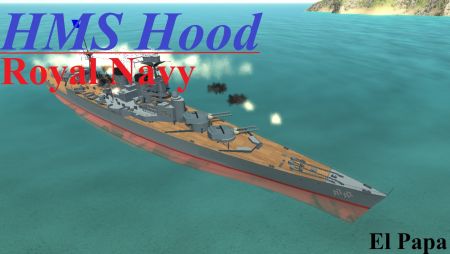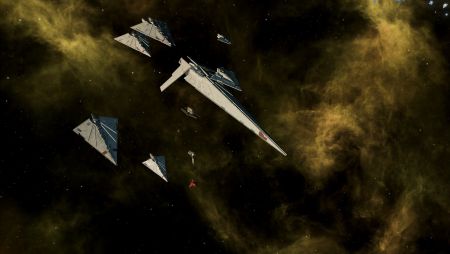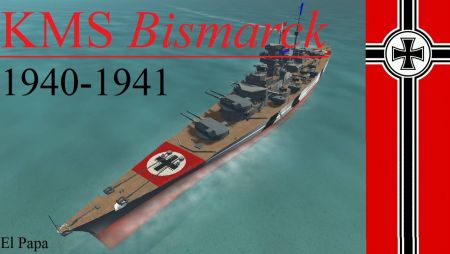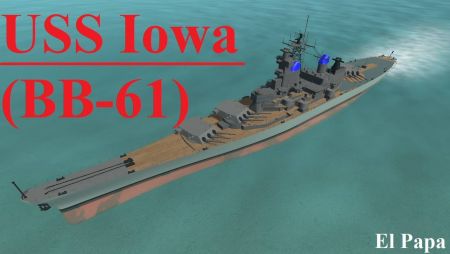Mod "The Bismarck Collection" version 22.05.19 for Ravenfield (Build 15)
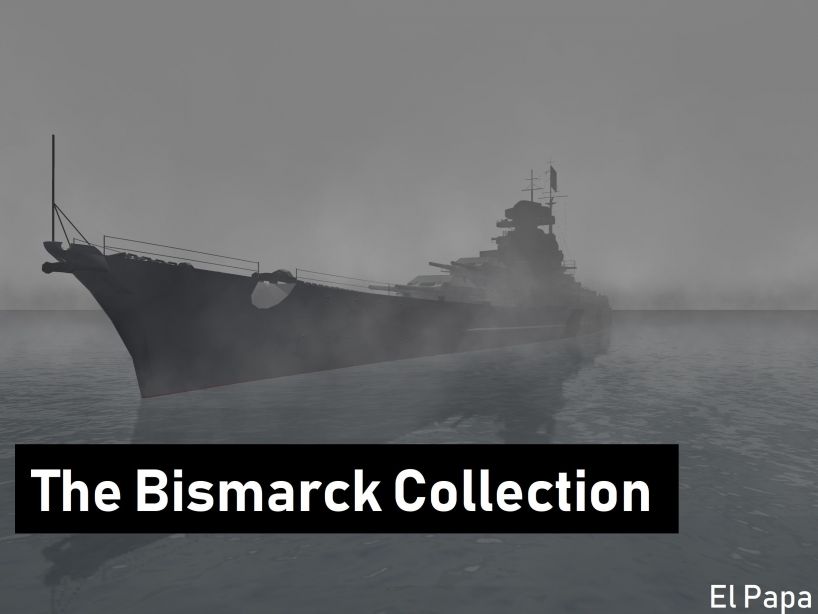
Background
On 24 May 1941 the Battle of the Denmark Strait took place resulting in the sinking of the Hood and the start of the hunt for the Bismarck resulting in its sinking on 27 May 1941. In memorial of this I am re-releasing my Bismarck, Hood and Swordfish mods with some improvements as well as the HMS King George V and the KMS Prinz Eugen.
RIP to the 3700 sailors on both sides who lost their lives in the engagements, they all served their nations with honour
Royal Navy
HMS Hood HMS Hood (pennant number 51) was the last battlecruiser built for the Royal Navy. Commissioned in 1920, she was named after the 18th-century Admiral Samuel Hood. One of four Admiral-class battlecruisers ordered in mid-1916, Hood had design limitations, though her design was revised after the Battle of Jutland and improved while she was under construction. For this reason, she was the only ship of her class to be completed. Despite the appearance of new and more modern ship designs over time, Hood remained the largest and most powerful warship in the world for 20 years after her commissioning, and her prestige was reflected in her nickname, "The Mighty Hood".
HMS King George V HMS King George V (pennant number 41) was the lead ship of the five British King George V-class battleships of the Royal Navy. Laid down in 1937 and commissioned in 1940, King George V operated during the Second World War in all three major theatres of war, the Atlantic, Mediterranean and Pacific, as well as part of the British Home Fleet and Pacific Fleets. In May 1941, along with HMS Rodney, King George V was involved in the hunt for and pursuit of the German battleship Bismarck, eventually inflicting severe damage which led to the German vessel's sinking.
Fairey Swordfish The Fairey Swordfish was a biplane torpedo bomber designed by the Fairey Aviation Company. Originating in the early 1930s, the Swordfish, nicknamed "Stringbag", was operated by the Fleet Air Arm of the Royal Navy, in addition to having been equipped by the Royal Air Force (RAF) alongside multiple overseas operators, including the Royal Canadian Air Force (RCAF) and the Royal Netherlands Navy. It was initially operated primarily as a fleet attack aircraft. During its later years, the Swordfish became increasingly used as an anti-submarine and training platform. The type was in frontline service throughout the Second World War, but it was already considered obsolete at the outbreak of the conflict in 1939.
Kriegsmarine
KMS Bismarck Bismarck was the first of two Bismarck-class battleships built for Nazi Germany's Kriegsmarine. Named after Chancellor Otto von Bismarck, the ship was laid down at the Blohm & Voss shipyard in Hamburg in July 1936 and launched in February 1939. Work was completed in August 1940, when she was commissioned into the German fleet. Bismarck and her sister ship Tirpitz were the largest battleships ever built by Germany, and two of the largest built by any European power.
KMS Prinz Eugen Prinz Eugen was an Admiral Hipper-class heavy cruiser, the third of a class of five vessels. She served with Nazi Germany's Kriegsmarine during World War II. The ship was laid down in April 1936, launched in August 1938, and entered service after the outbreak of war, in August 1940. She was named after Prince Eugene of Savoy, an 18th-century Austrian general. She was armed with a main battery of eight 20.3 cm (8.0 in) guns and, although nominally under the 10,000-long-ton (10,000 t) limit set by the Anglo-German Naval Agreement, actually displaced over 16,000 long tons (16,000 t).
On 24 May 1941 the Battle of the Denmark Strait took place resulting in the sinking of the Hood and the start of the hunt for the Bismarck resulting in its sinking on 27 May 1941. In memorial of this I am re-releasing my Bismarck, Hood and Swordfish mods with some improvements as well as the HMS King George V and the KMS Prinz Eugen.
RIP to the 3700 sailors on both sides who lost their lives in the engagements, they all served their nations with honour
Royal Navy
HMS Hood HMS Hood (pennant number 51) was the last battlecruiser built for the Royal Navy. Commissioned in 1920, she was named after the 18th-century Admiral Samuel Hood. One of four Admiral-class battlecruisers ordered in mid-1916, Hood had design limitations, though her design was revised after the Battle of Jutland and improved while she was under construction. For this reason, she was the only ship of her class to be completed. Despite the appearance of new and more modern ship designs over time, Hood remained the largest and most powerful warship in the world for 20 years after her commissioning, and her prestige was reflected in her nickname, "The Mighty Hood".
HMS King George V HMS King George V (pennant number 41) was the lead ship of the five British King George V-class battleships of the Royal Navy. Laid down in 1937 and commissioned in 1940, King George V operated during the Second World War in all three major theatres of war, the Atlantic, Mediterranean and Pacific, as well as part of the British Home Fleet and Pacific Fleets. In May 1941, along with HMS Rodney, King George V was involved in the hunt for and pursuit of the German battleship Bismarck, eventually inflicting severe damage which led to the German vessel's sinking.
Fairey Swordfish The Fairey Swordfish was a biplane torpedo bomber designed by the Fairey Aviation Company. Originating in the early 1930s, the Swordfish, nicknamed "Stringbag", was operated by the Fleet Air Arm of the Royal Navy, in addition to having been equipped by the Royal Air Force (RAF) alongside multiple overseas operators, including the Royal Canadian Air Force (RCAF) and the Royal Netherlands Navy. It was initially operated primarily as a fleet attack aircraft. During its later years, the Swordfish became increasingly used as an anti-submarine and training platform. The type was in frontline service throughout the Second World War, but it was already considered obsolete at the outbreak of the conflict in 1939.
Kriegsmarine
KMS Bismarck Bismarck was the first of two Bismarck-class battleships built for Nazi Germany's Kriegsmarine. Named after Chancellor Otto von Bismarck, the ship was laid down at the Blohm & Voss shipyard in Hamburg in July 1936 and launched in February 1939. Work was completed in August 1940, when she was commissioned into the German fleet. Bismarck and her sister ship Tirpitz were the largest battleships ever built by Germany, and two of the largest built by any European power.
KMS Prinz Eugen Prinz Eugen was an Admiral Hipper-class heavy cruiser, the third of a class of five vessels. She served with Nazi Germany's Kriegsmarine during World War II. The ship was laid down in April 1936, launched in August 1938, and entered service after the outbreak of war, in August 1940. She was named after Prince Eugene of Savoy, an 18th-century Austrian general. She was armed with a main battery of eight 20.3 cm (8.0 in) guns and, although nominally under the 10,000-long-ton (10,000 t) limit set by the Anglo-German Naval Agreement, actually displaced over 16,000 long tons (16,000 t).
Photos
Latest comments
Add a comment
Related Mods
Categories
Popular Mods
New Photos
Calendar of publications
| « January 2025 » | ||||||
|---|---|---|---|---|---|---|
| Mon | Tue | Wed | Thu | Fri | Sat | Sun |
| 1 | 2 | 3 | 4 | 5 | ||
| 6 | 7 | 8 | 9 | 10 | 11 | 12 |
| 13 | 14 | 15 | 16 | 17 | 18 | 19 |
| 20 | 21 | 22 | 23 | 24 | 25 | 26 |
| 27 | 28 | 29 | 30 | 31 | ||
 0
0
 8 911
8 911
 23-05-2019, 19:35
23-05-2019, 19:35

